ABCs: Fairfax dismisses print circulation as a ‘historical production metric’ as digital rebounds
Fairfax Media has recovered positive growth in its paywall subscribers after last quarter’s decline, with both The Age and The Sydney Morning Herald both achieving record figures according to the latest Audit Bureau of Circulation figures.
The Herald Sun posted the highest quarter-on-quarter digital subs growth, increasing its subscriptions by 12.11 per cent – 6,433 people- to 59,545 from April to June, as the AFL season got into full swing.
That total is less than half than city rival The Age, which has 136,498 subscribers, up 5.40 per cent, while The SMH has 139,988 subs, an increase of 6,286 (4.70 per cent).
News Corp’s The Australian posted a similar rate of growth to its Fairfax rivals, upping its digital subs by 3,137 (4.6 per cent growth).
Media analyst Steve Allen, principal of Fusion Media told Mumbrella the bounce back indicates the “March quarter digital subscriptions were an aberration”.
“The growth rates last quarter fell to five or six per cent from 10 or 12 per cent and this time it has bounced back up to 10 per cent plus, so it’s going back towards the trend line it had before,” he said.
Allen said while News Corp continues “to hold around a 70 plus per cent share of hard copy sales, Fairfax is by far the leader in digital with nearly the same share at 65 plus per cent”.
The full year comparison shows The Age up 6.5 per cent in weekday digital subscriptions, while weekday print subscriptions have fallen 11.4 per cent.
It was a similar picture over at The Sydney Morning Herald, however year on year weekday digital subs were up by nearly 10 per cent while weekday print subscriptions dropped by 12 per cent. Saturday print subscriptions dropped by 9.4 per cent while print subs to the Sun-Herald plunged by 13.9 per cent.
In response to the circulation numbers a Fairfax Media spokesperson dismissed print circulation as a “historical production metric”, backing the controversial EMMA readership metric as a more relevant barometer of performance.
“At Fairfax Media, our focus is on the audience that is consuming our content across all platforms and therefore, readership is a more accurate and modern metric. Readership gives us a clear picture of audience growth and engagement across print, websites, mobile and tablet,” the spokesperson said.
“As technology options for consumers evolve, readers are getting their news more frequently on digital platforms. As readers migrate to digital platforms, inevitably print readership will decline along with circulation. This also means that our audiences are growing, with more and more people consuming our valuable content every day. Fairfax has a bigger audience than ever before.
However, while its national business newspaper the Australian Financial Review had a 6.5 per cent fall on weekdays, its weekend edition was the only one to post positive growth – up 1 per cent – boosting its circulation by 601 copies to 62,643.
Over at News Corp, The Australian managed to just maintain it circulation above the 100,000 mark on weekdays, with a drop of 7.5 per cent, while its weekday digital subscriptions grew by 9.10 per cent. The Weekend Australian fared better, with print dropping by 3 per cent in the year-on-year comparisons, while digital subs were up 9.2 per cent.
A News Corp spokesman focused on the growth of the publisher’s digital subscriptions.
“The latest data release from the Audit Bureau of Circulation shows significant increases in net paid digital sales for our titles, providing further evidence of the success of our digital subscription program,” the spokesman said.
The Herald Sun was a positive for the publisher, with its weekday and weekend digital subs having all at least rocketed by 18 per cent. The weekday digital subs on the paper grew by 18.5 per cent, while digital subs to the Saturday edition were up by 19.3 per cent with the Sunday Herald Sun up by 19.7 per cent.
However, weekday print editions were down by 8.6 per cent, with subs to the Saturday paper down 7.8 per cent, and print subscriptions for the Sunday paper also down by 8.6 per cent.
Among its metropolitan tabloid titles News Corp still refuses to release digital subscription data for the Daily Telegraph, Courier Mail and Adelaide Advertiser.
A News Corp spokesman said the “ABC data shows that News Corp Australia continues to outperform its competitors and that we continue to see a slowing of circulation declines”.
“These numbers, together with the game-changing announcements we made at our recent Come Together event, demonstrate that News Corp Australia has a hugely powerful, compelling and unique proposition – one that sets us apart from anything else in the market.”
Looking across the weekday print editions, Fairfax Media’s Canberra Times had the biggest year-on-year fall, down by 18.9 per cent.
It was followed by Fairfax’s Sydney Morning Herald which posted a print circulation of 107,291 for the April to June period, a decline of 12 per cent on the same period last year.
The Age was not too far behind, with a drop of 11.4 per cent to settle on a circulation of 100,339.
The Mercury came in at fourth place with a decline of 8.7 per cent, while the Herald Sun dropped by 8.6 per cent. News Corp’s Daily Telegraph saw its print run slip by 8.5 per cent, while The Courier Mail dropped by 8.10 per cent.
The Daily Telegraph still managed to remain just above the 250k mark with a circulation of 256,835.
However, crocodiles, snakes and clacker-related headlines continue to be a solid combination for The Northern Territory News which had the smallest weekday decline of 4 per cent.
However, among the Saturday papers The Northern Territory posted the largest decline with its print circulation dropping from 21,962, to 19,709, a drop of 10.3 per cent.
Not far behind was the Advertiser, with a Saturday circ decline of 10 per cent. It still sits above the 150k mark with a circulation of 171,730.
Seven West Media’s West Australian Saturday edition posted the small decline, with its circulation numbers only slipping by 2 per cent to remain above the 250,000 mark with a circulation of 265,143.
Looking at the Sunday papers, News Corp’s Western Australian title the Sunday Times saw the greatest drop with a print run of 193,842, a decline of 11.1 per cent.
Once again the Northern Territory’s Sunday Territorian had the smallest slip with a decline of 6.1 per cent.
The Daily Tele’s Sunday Telegraph remains the highest selling paper with a circulation of 439,926, a drop of 9.9 per cent.


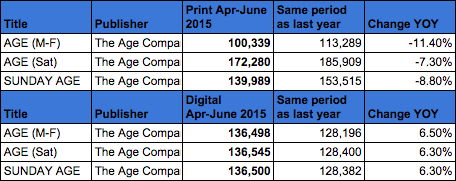
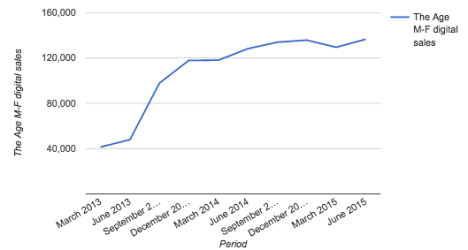
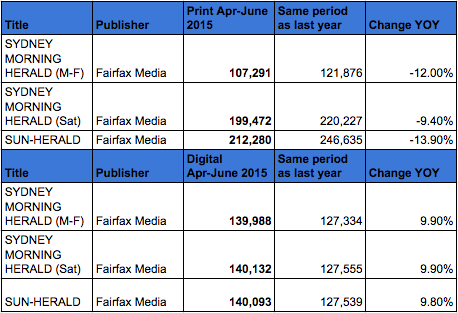
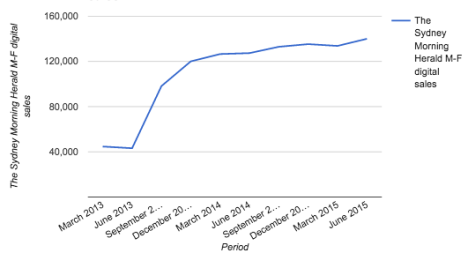

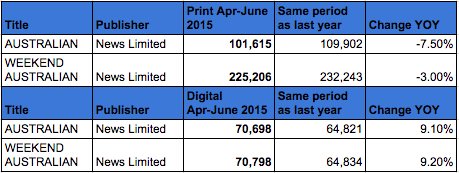
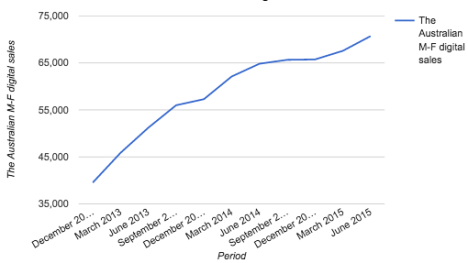
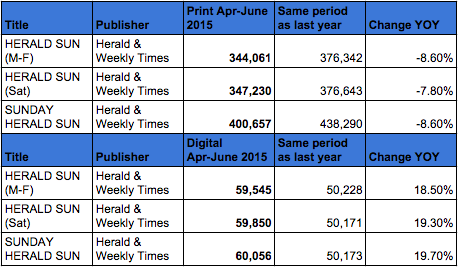
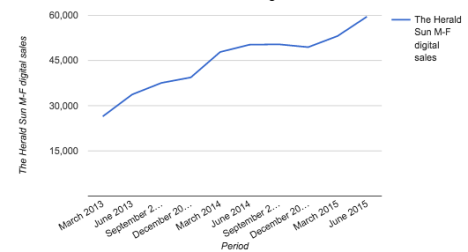
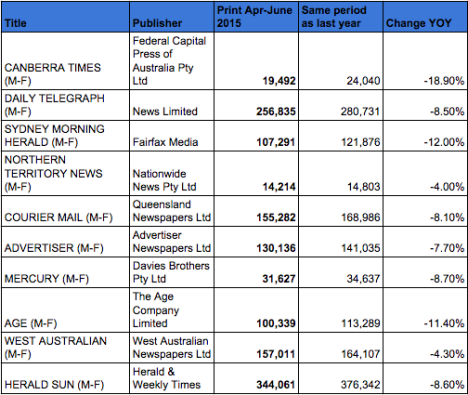
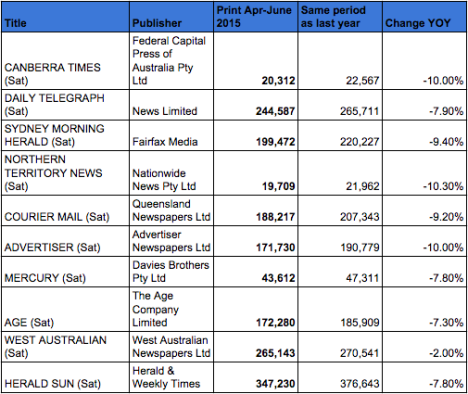
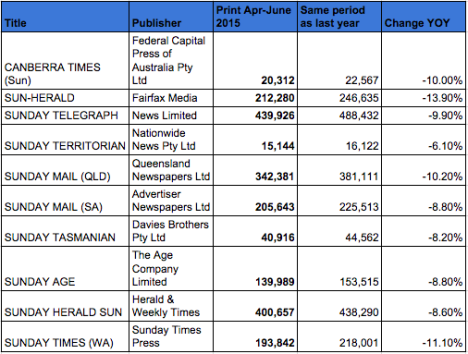

While there is no doubt that the disruption of media is a tough management job, Fairfax’s deliberate efforts to move the cheese on metrics is ridiculous. For starters: print ads is where its profit comes from today. To be clear: Domain won’t pay the bills (and is in any case in a cyclical sector that’s probably due to turn down). For seconds: there is no profit in digital traffic (unless you are as big as Google). For thirds: Fairfax’s confused strategy has demonstrably undermined its brand quality and will leave it with a bunch of half-baked, slimmed=down know-nothing newsrooms before very long at all.
Lets face it. Advertisers were being swindled for years. Readership figures were all based on assumption and speculation. Now, with digital, we know exactly how many likes, shares, followers and comments are happening and can delve a little deeper to work out whether these are of the quality we desire. The fat profits for media companies of yesterday are drying up, the industry is fragmenting and the old school suits are fighting to continue receiving an inflated pay check. Perhaps in the future, owners of media do not own yachts, who knows?
Wonder if they count all the free copies at airports in these figures?